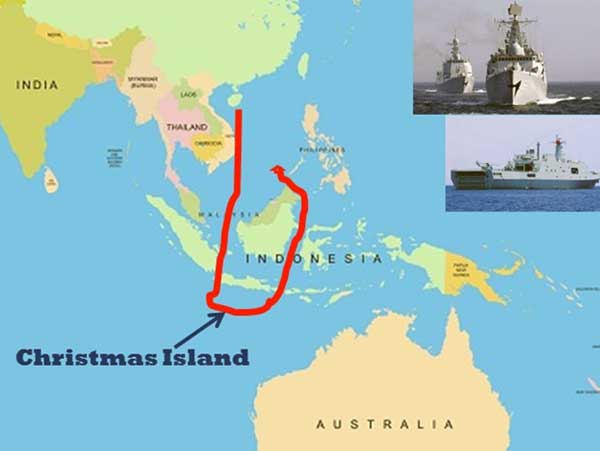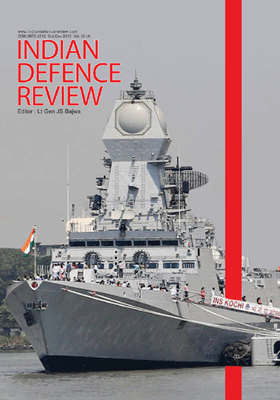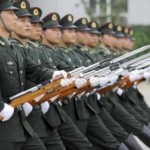Starting with the early part of the last decade, the Chinese had been carving out a plan that analysts in many parts of the world had assessed as a move to “contain” India. In India, the string was seen as a clever way of using excess money and excess capacity at home to “win” friends for a give-and-take game wherein the ‘take’ would translate in to use of ports and other infrastructure for the Chinese Navy, as well as for ‘special arrangements’ for Chinese trade.
…the Chinese have for the first time, learnt the art of maritime diplomacy by virtue of this deployment.
In many ways, the year 2005 was important for China to re-educate itself on the benefits of sea power. Then President Hu Jintao had been preparing the ground for over two years to celebrate China’s maritime heritage, and to revive its ancient love for venturing to the far seas. The occasion was the 600th anniversary of Admiral Zheng He’s Treasure Voyages which took place between 1405 and 1433. While the anniversary was celebrated with much fanfare, another important ‘announcement’ about Chinese vision emerged from the United States. Consultancy firm Booz Allen Hamilton had, in an analysis for the State Department, identified a Chinese strategy of creating maritime infrastructure in selected ports in the Indian Ocean (apart from some in the Pacific), and labeled it the string of pearls.
Starting with the early part of the last decade, the Chinese had been carving out a plan that analysts in many parts of the world had assessed as a move to “contain” India. In India, the string was seen as a clever way of using excess money and excess capacity at home to “win” friends for a give-and-take game wherein the ‘take’ would translate in to use of ports and other infrastructure for the Chinese Navy, as well as for ‘special arrangements’ for Chinese trade. All of that analysis is clearly falling in place as seen in Chinese warship movements into some of these ports as well as in the newly promulgated Maritime Silk Road.
PLA (Navy)’s Forays
Gulf of Aden. The best thing that could have ever happened to the Peoples Liberation Army (Navy) or PLAN was the menace of Somali piracy that peaked in the years 2007-2008. A couple of hijacking attempts on Chinese merchant ships in the Gulf of Aden, and an embarrassing incident when another navy’s frigate on patrol rescued a Chinese trader, got the PLAN involved in the anti-piracy mission in Dec 2008. Chinese warships have since been coming to the Gulf of Aden in the form of a Task Force of three ships comprising two destroyers/frigates, and one comprehensive supply ship (Logistics Ship). Each Task Force stays on station for three to four months, before being relieved by its successor. The comprehensive supply ship stays for six to seven months, serving two consecutive Task Forces.
It helps the cause of China’s strategic heft in the most important ocean, and it serves the objective of watching India’s backyard at close quarters before trying to “contain” it.
Currently the 20th Task Force is on duty and is scheduled to get relieved by the 21st Task Force which should be ‘on station’ in the Gulf, by end August. This activity, initially thought by the Chinese, to be a military and economic burden on the country, has proved to be the greatest boon for accumulation of sea power of the State. Firstly, it has made the Chinese earn their sea legs for deployment in distant waters, and have moved the PLAN in to the Blue Water mould. Secondly, the Chinese have for the first time, learnt the art of maritime diplomacy by virtue of this deployment. The formerly shy PLAN officers, who were hitherto restricted in their contact with foreigners, were allowed to interact with other navies’ personnel after the first year of deployment in the Gulf of Aden got over. More significantly, each Task Force, was charged to route via a couple of countries on its way home, to re-establish friendship and institute such confidence building measures (CBMs) through exercises, as would make for partners beyond friendship. In this effort, the homeward journey of the 16th Task Force has been the most noteworthy so far.
On leaving the Gulf of Aden, that Task Force was routed via the Mediterranean, and the West coast of Africa, before returning home. Enroute, it visited eight countries including seven on the West African coast. These went beyond just “goodwill” visits. All the countries visited were countries of significance in the Chinese strategy of creating and nurturing new pearls in various oceans.
What has surprised the world is the fact that while piracy in the area has almost disappeared since 2012, the Chinese are steadfast in their newfound occupation. The first reason is not difficult to assess. The Chinese have suddenly realised the benefits of maintaining station in the North Indian Ocean, where they were always looking for an excuse to establish their presence. It helps the cause of China’s strategic heft in the most important ocean, and it serves the objective of watching India’s backyard at close quarters before trying to “contain” it.
The second reason is that for China, the Gulf of Aden is half way to anywhere else in the world! So why not maintain station with a fully capable flotilla, in the name of providing security to international shipping? And, a test of this geographic theorem came in 2011 during the Libyan crisis when the Chinese had the largest numbers to be evacuated from the port city of Benghazi.
China’s interest in the Indian Ocean also stems from its locational advantage for tracking its satellites.
Frigate Xuzhou from the Seventh Task Force in the Gulf of Aden was dispatched to supervise and protect all the Chinese evacuees who were ferried to Greece and Malta, before being airlifted home. Then, in end March 2015, when the Yemen crisis erupted, one of the three ships of the 19th Task Force was diverted to Aden harbour (just next door), to ferry the 400 odd Chinese citizens to Djibouti for further airlift to mainland China. The Chinese were the first ones to be able to dock a warship in Aden harbour – thanks to its location within the Gulf of Aden where their Task Force operates.
Just a month and a half later (May 2015), the annual Sino-Russian Bilateral Exercise was inaugurated in Novorossiysk in the Black Sea, and conducted in the Eastern Mediterranean. The PLAN dispatched all three ships of the 19th Task Force which was concluding its three month mission, to participate in that exercise. It was not just found convenient to nominate the 19th Task Force for this deployment in the Mediterranean, but was obviously done as per a plan scheduled from beforehand! Perhaps the reason for shifting the exercise from the Western Pacific (its normal locale since inception in 2012), to the Mediterranean, was also to utilize the Task Force after its duty in the Gulf of Aden, while simultaneously projecting PLAN’s ‘far seas’ deployment capability, to the world.
So, China will not like to wind up from the Gulf of Aden. And now, the latest Defence White paper, released in May, 2015 – for the first time titled as China’s Military Strategy – clearly states that the PLA (Armed Forces) will continue to discharge their duty in the Gulf of Aden. Clearly, as suspected two years ago when other navies had started reducing their presence because of a decline in piracy, China is here to maintain “presence” in the classical naval sense. Recently, there has also been substantial news that the possibility of a Chinese Logistics Base in Djibouti is now closer to reality. That would mean a base and not just a place within the Indian Ocean.
The string of pearls was initially appreciated by some, to serve the purpose of securing China’s energy lines of communication, in fact its “strategic” lines of communication in the IOR…
Other Locations. In end 2013, a PLAN flotilla, comprising of the Expeditionary Operations platform Changbaishan, and two destroyers, Wuhan, and Haikou steamed down from Hainan Island, down the Sunda Strait, almost hugged the Christmas Island in the Indian Ocean (belonging to Australia), and turned North through the Lombok Strait. This flotilla carried out maneuvers throughout its passage including through the International Straits within the Indonesian Archipelago. This adventure seemed a deliberate move by the Chinese to firstly test the reactions of Indian Ocean states – particularly Australia, India, and Indonesia, and secondly to tell the world that China’s new maritime capability had translated its expansionist strategy in to action.
Submarine Force
In end 2013, the Foreign Affairs Department of China’s Ministry of Defence informed the missions of six countries including India, Pakistan, Russia, and United States that one of its nuclear powered Attack submarines (NATO code: SSN), would be making an entry into the Indian Ocean. This was the first time ever that any nation owning nuclear powered submarines was announcing its intentions to “patrol” certain waters. Even conventional submarine’ patrols are never promulgated. But the reasons for doing so was twofold: first, to deliberately tell the world that China is now a player in the elite club; second, to forewarn all littorals and nuclear powers operating submarines, of the presence of a Chinese submarine so far away from home, that could need assistance in any eventuality. (Till 2013, PLAN nuclear powered submarines were reported to have had some glitches in their propulsion/control systems, because of which they had never been deployed for prolonged patrols even within home waters). This excursion was the first ever by a Chinese strategic platform in to waters of the Indian Ocean.
PLAN submarines have started making “visible” forays into the Indian Ocean is in itself a matter of serious concern to not only India but also many other powers – within and without the Indian Ocean.
In 2014, two Chinese submarines called at Colombo South port in September and November respectively, a move that was seen as intimidating to the peaceful texture of the Indian Ocean. (The first submarine in Sep 2014 was also accompanied by a Submarine Support Vessel). In all likelihood, it was the same submarine – a Song Class – that called at Colombo, first on its way to the Gulf of Aden, and then on its return. What made these port calls intriguing to India were not only the visits but also the explanations offered by the two sides.
As per China’s Xinhua news agency, a Chinese Ministry of National Defence spokesperson said after the September visit: “It is an international common practice for submarines to stop for refueling and crew refreshment at an overseas port.”1 He also laboured the point that the PLAN’s submarines were joining the Surface Task Force in the Gulf of Aden, to supplement the anti-piracy mission (!) The Sri Lankan statement went a step further to paint it in the ‘business as usual’ colour. It read: “A submarine and a warship have docked at Colombo harbour ….. there is nothing unusual ……. Since 2010, 230 warships have called at Colombo Port from various countries, on goodwill visits and for refueling and crew refreshment.”2
The fact that PLAN submarines have started making “visible” forays into the Indian Ocean is in itself a matter of serious concern to not only India but also many other powers – within and without the Indian Ocean. Over the last decade, there have been many pieces of news that had indicated Chinese submarines having made quiet patrols in the Indian Ocean. But none was ever seen on snort (breathing to charge batteries), or calling at friendly ports, and therefore news – whether from international sources, or as a result of media speculation – remained unconfirmed. The repeated visits now (including the most recent one at Karachi), however, appear to be a deliberate move by China, to nudge all interested powers, particularly India, with a catch-me-if-you-can nuance.






